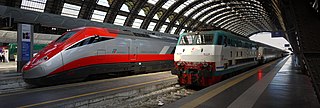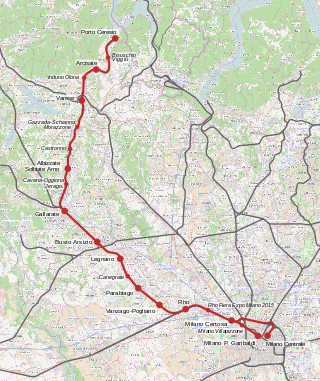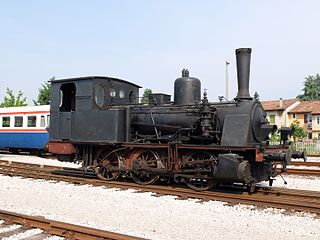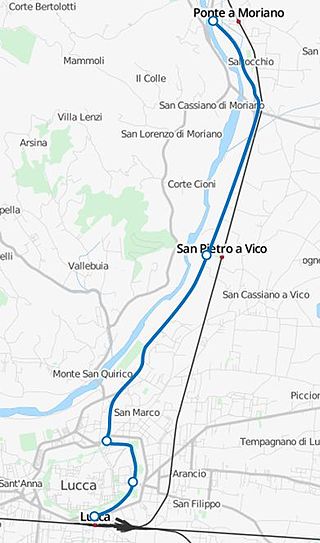
The Italian railway system is one of the most important parts of the infrastructure of Italy, with a total length of 24,227 km (15,054 mi) of which active lines are 16,723 km (10,391 mi). The network has recently grown with the construction of the new high-speed rail network. Italy is a member of the International Union of Railways (UIC). The UIC Country Code for Italy is 83.

Montebelluna is a city and comune in Veneto, Italy, approximately 50 kilometres (31 mi) northwest of Venice. It has an estimated population of 32,000.

The Italian railway system is one of the most important parts of the infrastructure of Italy, with a total length of 24,227 km (15,054 mi) as of 2011.

The Milan–Bologna railway is the northern part of the traditional main north–south trunk line of the Italian railway network. It closely follows the ancient Roman Road, the Via Aemilia. The line was opened between 1859 and 1861 as a single-line railway, and was doubled between 1866 and 1894. It was electrified at 3,000 volts DC in 1938. High-speed trains on the route have used the parallel Milan–Bologna high-speed line since 13 December 2008.

The Genoa–Pisa railway is one of the trunk lines of the Italian railway network. It runs along the Ligurian coast from Genoa to Pisa through the Riviera di Levante and the Versilia. It passes through the cities of Massa, Carrara and La Spezia. South of Pisa the Pisa–Rome line continues along the Tyrrhenian coast to Rome. The line is double track and is fully electrified at 3,000 V DC. Passenger traffic is managed by Trenitalia.

The Verona–Bologna railway is a major Italian railway connecting Verona and Bologna and part of the major axis from the Brenner railway to the Bologna–Florence and on to Rome. The line is part of the Line 1 of Trans-European Transport Networks (TEN-T). It is considered a "fundamental" line by the state railways Ferrovie dello Stato (FS).

Padova railway station, or Padua railway station, sometimes referred to as Padova Centrale, is the main station serving the city and comune of Padua, in the Veneto region, northeastern Italy.

Treviglio railway station, also known as Treviglio centrale railway station is the main station serving the town and comune of Treviglio, in the region of Lombardy, northern Italy. Opened in 1878, it has a higher average number of passengers per day than Treviglio's other railway station, Treviglio Ovest.

Porto Ceresio–Milan railway is a railway line in Lombardy, Italy. It uses the tracks of the Milan–Arona railway until Gallarate.

The Ferrovie dello Stato Italiane Class 600, formerly Rete Adriatica Class 380 and Società per le Strade Ferrate Meridionali Class 380, is a 2-6-0 'Mogul' steam locomotive; it is considered by some as the first Italian modern steam locomotive.

The Genova–Casella railway is a narrow gauge (1000 mm) railway in Liguria (Italy) that connects the city of Genoa to Casella, a village in the mountains inland from the city.

The Ferrovie dello Stato Class 741 is a class of 2-8-0 'Consolidation' steam locomotives, rebuilds from the FS Class 740 with a Franco-Crosti boiler; it was the last class of steam locomotives introduced in Italy.

FS Class 113 was a class of 0-4-2 steam locomotives of the Ferrovie dello Stato (FS), inherited from older railway companies on the nationalization of Italian railways in 1905. They were built by Gio. Ansaldo & C. between 1854 and 1869.

This article lists rolling stock of Società Veneta. It is not complete.

FS Class 400 were steam locomotives of French construction, built for service in Italy. They were 0-8-0 tender locomotives with two outside cylinders.
Tarvisio–Udine railway is an Italian railway line that connects Udine and Tarvisio. It is also called the ferrovia Pontebbana in Italian after the town of Pontebba, which was located near the former border between Italy and Austria-Hungary during the first thirty years of its operation.
The Naples–Foggia railway is an Italian railway line connecting Naples, in Campania, with Foggia, in Apulia, crossing the Apennines at the saddle of Ariano through a series of tunnels.

The Lucca–Ponte a Moriano Tramway was an urban steam tramway line that connected Lucca railway station with a renowned jute factory in Ponte a Moriano. The line was closed in 1932 and ran almost parallel to the Lucca–Aulla railway.

The Verona-Affi-Caprino railway with the Affi-Garda branch line was an Italian railway that connected Verona to Lake Garda and the slopes of Mount Baldo, passing through Valpolicella. The route fell entirely within the territory of the Province of Verona.

Class 851 locomotives were a class of steam locomotives of the Italian State Railways (FS).




























